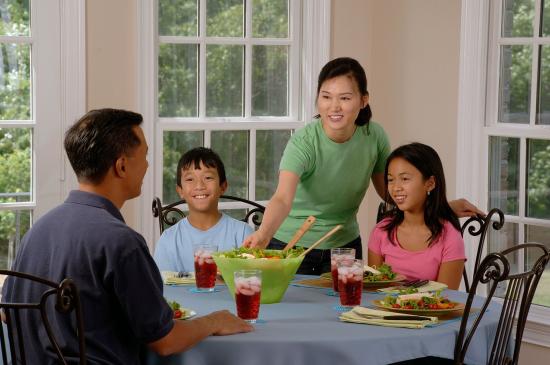
Are you are bored and clicking through old TV shows (think, TVLand)? Have you noticed something similar in most of those shows? Families sit at the dinner table, share a meal, laugh and talk to one another. It’s what used to happen in many American households. Unfortunately, due to our busyness, commuting and other factors, the American family has pretty much lost this important tradition. However, during this challenging time of staying at home, family meals are making a comeback. Perhaps this is one of the positive things to come out of the pandemic.
According to a number of studies, families who eat meals together reap a host of benefits. So, during this time of quarantine, take time to eat together but also to prepare meals together. When I was a teen, I learned to cook helping my mother and grandmother in the kitchen. I watched how they made a roux, gravies, pies and more. I was “home” schooled in cooking. And because we are all “homeschooling,” now is the time to revive this tradition. When you do, make your dinner time pleasant, fun and enjoyable.
If motivation to make this change is a problem, consider these 7 benefits. Families who eat meals together:
1) Decrease their child’s likelihood to drink, smoke or use illegal drugs.
2) Decrease a teen’s likelihood to have sex at a young age.
3) Decrease their child’s likelihood to get in fights, be suspended from school or become suicidal.
4) Improve nutrition of their family members and eat healthier.
5) Improve family relationships and intimate connections.
6) Improve a child’s academic success.
7) Improves a child’s self-esteem and resilience.
What incredible benefits! All you have to do is eat together. Prioritize this for your family. Hey, quarantine is allowing us to develop good habits. Hopefully, knowing all the benefits of family meals, this is a habit you will continue long after our stay at home time ends.
Sources:
Columbia News, CASA 2000 Teen Survey. Teens With “Hands-Off” Parents at Four Times Greater Risk of Smoking, Drinking, and Using Illegal Drugs as Teens With “Hands-On” Parents, last referenced 10/1/2002.
Sandra L. Hofferth, “Changes in American Children’s Time,”1981-1997.” University of Michigan’s Institute for Social Research, Center Survey, January, 1999. National probability samples of American families with children ages 3-12, using time diary data from 1981 and 1997. Findings on how time use is associated with children’s well-being are reported in Hofferth, S. L., “How American Children Spend Their Time,” Journal of Marriage and the Family, (2001).63, 295-308. Retrieved online October 4, 2004, from http://216.239.41.104/search?q=cache:H5jg_Q0-v74J:edprojects.che.umn.edu/takeback/downloads/research.pdf+overscheduled+kids+and+underconnected+families&hl=en
Gillman, M.W., Rifas-Shiman, S.L., Frazier, A.L., Rockette, H.R.H., Camargo, C.A., Field, A.E., Berkey, C.S., & Colditz, G.A. “Family Dinners and Diet Quality Among Older Children and Adolescents,” Archives of Family Medicine,(2000). 9,235-240. A questionnaire using 24- hour recall that was mailed to children of participants in the ongoing Nurses Health Study II. Retrieved online October 6, 2004, from http://216.239.41.104/search?q=cache:H5jg_Q0v74J:edprojects.che.umn.edu/takeba


